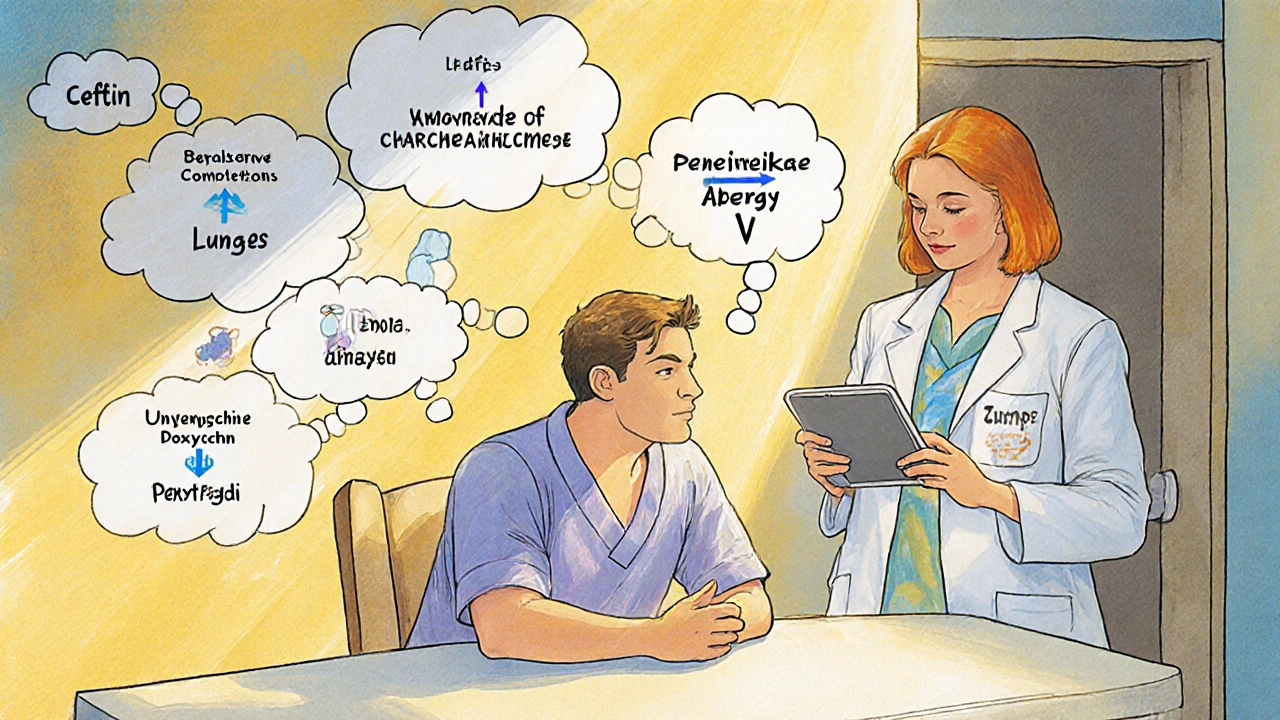Antibiotic Selection Guide
Find the Best Antibiotic for Your Situation
Answer a few questions to determine which antibiotic might be most appropriate for your infection or condition.
When your doctor writes Ceftin on the prescription pad, you might wonder how it measures up against the other pills in the cabinet. This guide breaks down Ceftin (generic name cefuroxime) and lines it up against the most common alternatives so you can see where it shines and where another drug might be a better fit.
Ceftin is a brand‑name oral cephalosporin antibiotic (generic cefuroxime) used to treat a range of bacterial infections. It belongs to the second‑generation cephalosporin class, which means it has a broader spectrum than first‑generation agents like penicillin but isn’t as heavy‑handed as some later‑generation drugs.
How Ceftin Works
Cefuroxime interferes with bacterial cell‑wall synthesis by binding to penicillin‑binding proteins. Without a sturdy wall, bacteria burst under their own pressure. Because it targets a wide variety of gram‑positive and gram‑negative organisms, Ceftin is often chosen for respiratory, ear, sinus, and urinary‑tract infections.
Typical Ceftin Prescribing Scenarios
- Acute bacterial sinusitis
- Community‑acquired pneumonia
- Uncomplicated urinary tract infection (UTI)
- Skin and soft‑tissue infections caused by susceptible bacteria
- Middle ear infections (otitis media) in adults and children
Common Alternatives to Ceftin
Below are the antibiotics doctors frequently consider when Ceftin isn’t ideal. Each has its own spectrum, dosing convenience, and side‑effect profile.
| Antibiotic | Spectrum | Typical Use | Standard Adult Dose | Common Side Effects | Cost (US$) |
|---|---|---|---|---|---|
| Cefuroxime (Ceftin) | Broad (2nd‑gen cephalosporin) | Respiratory, sinus, UTI, skin | 250‑500 mg q12h | Diarrhea, nausea, rash | 15‑20 (generic) |
| Amoxicillin | Narrow‑to‑moderate (penicillin) | Otitis media, strep throat, mild pneumonia | 500 mg q8h | Allergic reactions, GI upset | 5‑10 |
| Azithromycin | Moderate (macrolide) | Chlamydia, atypical pneumonia, traveler's diarrhea | 500 mg day 1, then 250 mg daily x4 | QT prolongation, abdominal pain | 12‑18 |
| Doxycycline | Broad (tetracycline) | Lyme disease, acne, MRSA‑susceptible skin infections | 100 mg bid | Photosensitivity, esophagitis | 8‑14 |
| Penicillin V | Very narrow (penicillin) | Strep throat, mild skin infections | 500 mg q6h | Allergy, GI upset | 4‑8 |
Pros and Cons of Ceftin Compared to Each Alternative
- Versus Amoxicillin: Ceftin covers more gram‑negative bugs, making it a better choice for mixed infections. However, amoxicillin is cheaper and has decades of safety data, so it stays first‑line for simple strep throat.
- Versus Azithromycin: Ceftin doesn’t carry the same cardiac risk (QT prolongation) and is less likely to cause antibiotic‑associated diarrhea. Azithromycin wins on dosing convenience (once daily for five days) and is preferred for atypical pathogens.
- Versus Doxycycline: Both are broad, but doxycycline can treat intracellular organisms (e.g., Chlamydia) and is effective against certain MRSA strains. Ceftin is safer for pregnant patients, whereas doxycycline is contraindicated.
- Versus Penicillin V: Ceftin’s broader spectrum means it can handle resistant streptococci that penicillin can’t. Penicillin V remains the cheapest option and is ideal for confirmed streptococcal pharyngitis.
How to Choose the Right Antibiotic
Picking the best drug isn’t just about price; it’s about matching the pathogen, patient factors, and safety. Follow this quick decision flow:
- Identify the infection site (sinus, lung, urinary, skin).
- Check local resistance patterns - if >20 % of Streptococcus pneumoniae are resistant to penicillin, consider Ceftin.
- Review patient allergies - a penicillin‑allergic patient can often tolerate cefuroxime.
- Consider comorbidities - renal impairment may require dose adjustment of Ceftin; liver disease is a concern with macrolides.
- Weigh convenience - a single‑dose azithromycin regimen beats a twice‑daily Ceftin course for compliance.

Safety Profile & Common Side Effects
Cefuroxime is generally well‑tolerated. About 10‑15 % of users report mild gastrointestinal upset (nausea, diarrhea). A rash can indicate a hypersensitivity reaction; in rare cases, severe allergic responses (anaphylaxis) occur. Compared with some alternatives, Ceftin has a lower risk of:
- Cardiac arrhythmias (no QT effect)
- Photosensitivity (unlike doxycycline)
- Clostridioides difficile infection (risk still present but lower than broad‑spectrum carbapenems)
If you’re pregnant, Ceftin is Category B (no proven risk in animal studies), making it a safer option than doxycycline or fluoroquinolones.
Key Takeaways
- Ceftin offers a balanced spectrum for many common infections without the high cost of newer agents.
- Amoxicillin remains first‑line for simple streptococcal infections; reserve Ceftin for mixed or resistant cases.
- Azithromycin shines when dosing convenience matters, but watch for heart‑related side effects.
- Doxycycline is useful for intracellular bugs and certain skin infections, but avoid in pregnancy.
- Always factor in local resistance data, patient allergies, and organ function before selecting an antibiotic.
Is Ceftin safe for children?
Yes. Cefuroxime is approved for pediatric use down to 3 months old for conditions like otitis media, sinusitis, and pneumonia. Dosing is weight‑based and usually well‑tolerated.
Can I take Ceftin with food?
Cefuroxime tablets can be taken with or without food. However, taking it with a meal may reduce stomach upset for some patients.
How does Ceftin compare to amoxicillin for a urinary tract infection?
Amoxicillin covers many common UTI pathogens but struggles with E. coli strains that produce beta‑lactamase. Cefuroxime’s beta‑lactamase resistance makes it a stronger option when resistance is suspected.
What should I do if I develop a rash while on Ceftin?
Stop the medication immediately and contact your healthcare provider. A rash can signal an allergic reaction that may require a different antibiotic.
Is there any interaction between Ceftin and alcohol?
There’s no direct chemical interaction, but drinking alcohol can worsen gastrointestinal side effects like nausea and dizziness.

Penny Reeves
October 19, 2025 AT 20:11While the table presents the data, it's evident that many clinicians overlook the pharmacoeconomic nuances that truly dictate therapy selection.
Sunil Yathakula
October 23, 2025 AT 21:24Totally get how confusing these choices can be-just remember, if you’re feeling queasy on Ceftin, taking it with a snack might help u feel better.
Catherine Viola
October 27, 2025 AT 21:38It is imperative to recognize that the pharmaceutical industry's influence extends beyond mere marketing; the subtle bias embedded within guideline committees often skews perceived superiority of newer agents such as Ceftin. Moreover, the alleged “broad spectrum” claim may conceal strategic attempts to marginalize older, cost‑effective options like amoxicillin. One must remain vigilant against such covert manipulation.
sravya rudraraju
October 31, 2025 AT 22:51When evaluating antimicrobial options, it is essential to consider both the microbiological coverage and the patient’s individual circumstances. Ceftin’s activity against beta‑lactamase‑producing organisms provides a distinct advantage in settings where resistance patterns are shifting. However, the convenience of a twice‑daily regimen may pose adherence challenges for certain populations, particularly those with complex medication schedules. In contrast, azithromycin’s once‑daily dosing offers superior compliance, albeit with its own safety considerations. The clinician should also weigh renal function, as dose adjustment of cefuroxime is mandatory in impaired clearance. From a cost perspective, generic Ceftin remains moderately priced, but amoxicillin continues to dominate budgetary allocations. It is also noteworthy that Ceftin holds a favorable safety profile in pregnancy, a factor not to be dismissed lightly. By integrating local antibiogram data, prescribers can tailor therapy to achieve optimal outcomes while minimizing collateral damage to the microbiome. Ultimately, a balanced approach that aligns drug properties with patient-specific factors will yield the most prudent therapeutic decision.
Ben Bathgate
November 5, 2025 AT 00:04Honestly, most of the hype around Ceftin is just marketing fluff; cheaper generics get the job done for the majority of infections.
Ankitpgujjar Poswal
November 9, 2025 AT 01:18Stop doubting the efficacy-Ceftin punches through resistant strains like a champ, so trust the drug and stay firm in your prescription choices.
Christopher Burczyk
November 13, 2025 AT 02:31From a pharmacodynamic standpoint, cefuroxime’s affinity for penicillin‑binding proteins confers a predictable bactericidal effect, thereby justifying its placement in empiric therapy algorithms for mixed‑flora infections.
Caroline Keller
November 17, 2025 AT 03:44We are all doomed if we keep letting big pharma dictate our antibiotics choices.
dennis turcios
November 21, 2025 AT 04:58Ceftin does fill a niche, yet its side‑effect profile isn’t dramatically better than alternatives, so use it judiciously.
Felix Chan
November 25, 2025 AT 06:11Choosing the right antibiotic can feel overwhelming, but remember that each option has its strengths. Ceftin offers a solid middle ground between narrow and ultra‑broad coverage, making it versatile for many common infections. Its twice‑daily dosing is manageable for most adults, and the pill can be taken with food to reduce stomach upset. For patients who struggle with adherence, azithromycin’s five‑day regimen remains appealing. Meanwhile, amoxicillin’s low cost and long safety record keep it at the front of the line for simple cases. Doxycycline shines when dealing with intracellular pathogens and provides an anti‑inflammatory benefit for skin conditions. If you’re pregnant, Ceftin’s category B status offers reassurance, unlike doxycycline which is contraindicated. Side‑effects like diarrhea and rash are relatively infrequent, and serious allergic reactions remain rare. Always check local resistance patterns; in areas with high beta‑lactamase activity, cefuroxime’s resilience becomes a decisive factor. Renal dosing adjustments are straightforward, ensuring safety for patients with kidney concerns. Cost considerations should not eclipse clinical efficacy, but generic Ceftin is reasonably priced compared with newer agents. By partnering with your healthcare provider, you can weigh these nuances and make an informed choice. Remember that antibiotic stewardship protects not only your health but also community health. Stay proactive, stay informed, and trust that evidence‑based medicine will guide you to the best outcome.